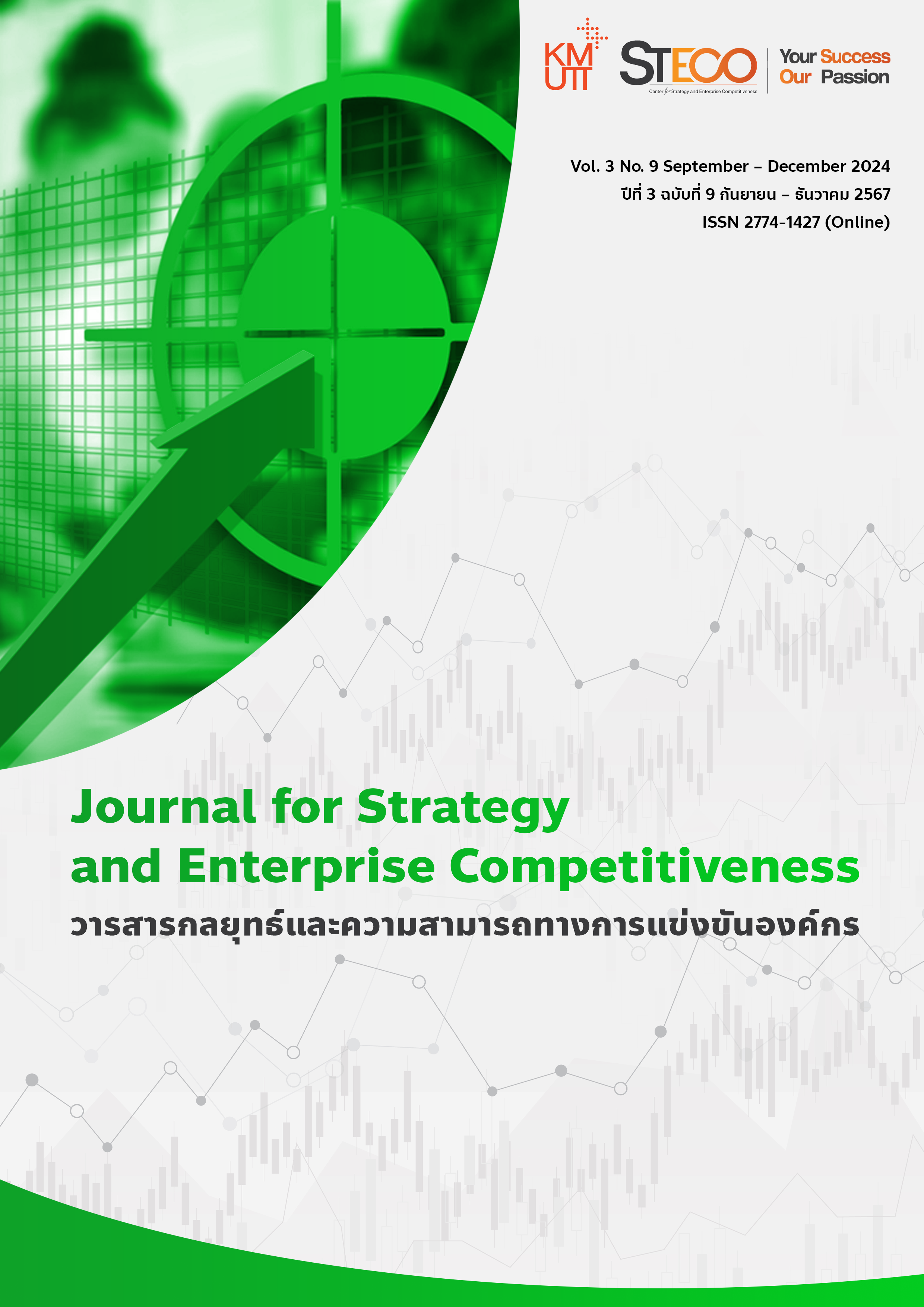ความสัมพันธ์ระหว่างสัดส่วนการก่อหนี้ที่ส่งผลต่อผลการดำเนินงานภายใต้สถานการณ์ โควิด-19 ของบริษัทกลุ่มอุตสาหกรรมอสังหาริมทรัพย์ในตลาดหลักทรัพย์แห่งประเทศไทย
คำสำคัญ:
สัดส่วนการก่อหนี้, ผลการดำเนินงาน, อุตสาหกรรมอสังหาริมทรัพย์, สถานการณ์โควิด-19บทคัดย่อ
สถานการณ์โควิด-19 พบว่า บริษัทในกลุ่มอุตสาหกรรมอสังหาริมทรัพย์ได้รับผลกระทบ
จากการดำเนินงาน โดยการศึกษานี้มีวัตถุประสงค์ เพื่อศึกษาความสัมพันธ์ระหว่างสัดส่วนการก่อหนี้
กับผลการดำเนินงานของบริษัทในกลุ่มอุตสาหกรรมอสังหาริมทรัพย์ที่จดทะเบียนในตลาดหลักทรัพย์แห่งประเทศไทย ภายใต้สถานการณ์โควิด-19 โดยเก็บรวบรวมข้อมูลจากรายงานประจำปีแบบ 56-1 ซึ่งเป็นรายงานประจำปีที่สำนักงานคณะกรรมการกำกับหลักทรัพย์และตลาดหลักทรัพย์ (ก.ล.ต.) กำหนดให้บริษัทจดทะเบียน โดยเก็บจากกลุ่มตัวอย่าง 150 งบการเงินจาก 50 บริษัท ในช่วงระยะเวลา 3 ปี ในช่วงสถานการณ์
โควิด-19 ระหว่างปี พ.ศ. 2562 ถึง พ.ศ. 2564 โดยใช้สถิติการวิเคราะห์ความถดถอยเชิงพหุคูณ ผลการศึกษาพบว่า สัดส่วนการก่อหนี้ไม่มีความสัมพันธ์กับอัตราผลตอบแทนของสินทรัพย์ ในขณะที่สัดส่วนการก่อหนี้
มีความสัมพันธ์ในทิศทางตรงกันข้ามกับอัตราผลตอบแทนต่อผู้ลงทุนและอัตราผลตอบแทนจากเงินลงทุน
โดยงานวิจัยนี้สามารถนำไปใช้เพื่อเป็นประโยชน์ในการศึกษาและนำไปวัดผลจากโครงสร้างของบริษัท
ในช่วงสถานการณ์โควิด-19
เอกสารอ้างอิง
Ahsan, T., Wang, M., & Qureshi, M. A. (2016). Firm, industry, and country-level determinants of capital structure: Evidence from Pakistan. South Asian Journal of Global Business Research, 5(3), 362-384.
Apinyamas Chompoo. (2020). The Relationship Between Profitability and Debt Management with Dividend on The Stock Exchang of Thailand (SET100). The Degree of Master of Accounting. Sripathum University.
Beneish, M. D. (2001). Earnings management: A perspective. Managerial Finance, 27(12), 3-17. Bester, H., & Scheepens, J. P. (1996). Internal finance versus bank debt: the gains from establishing a debt history. Credit and Capital Markets–Kredit und Kapital, 29(4), 565-591.
Booth, L., Aivazian, V., Demirguc-Kunt, A., & Maksimovic, V. (2001). Capital structures in developing countries. The Journal of Finance, 56(1), 87-130.
Brigham, J. C., Bennett, L. B., Meissner, C. A., & Mitchell, T. L. (2007). The influence of race on eyewitness memory. In The Handbook of Eyewitness Psychology, 2, 271-296.
Campbell, D. E., & Kelly, J. S. (1994). Trade-off theory. The American Economic Review, 84(2), 422-426.
Chen, Y., Wang, M., & Zhang, H. (2020). The impact of financial leverage on firm performance: Evidence from Chinese manufacturing firms. Journal of Financial Studies, 45(3), 321- 338.
Cohen, J., Cohen, P., West, S. G., & Aiken, L. S. (2013). Applied multiple regression/correlation analysis for the behavioral sciences. Routledge.
Damodaran, A. (2016). Damodaran on valuation: security analysis for investment and corporate finance. John Wiley & Sons.
Frank, M. Z., & Goyal, V. K. (2009). Capital Structure Decisions: Which Factors Are Reliably Important? Financial Management, 38(1), 1–37.
Flynn, S. J. (2017). Debt structure and future financing and investment. Arizona State University.
Hair, J. F., Black, W. C., Babin, B. J., & Anderson, R. E. (2014). Multivariate data analysis: Pearson new international edition. Essex: Pearson Education Limited, 1(2).
Jiraporn, N. (2019). The Relationship Between Financial Ratios and Investment Returns in Securities: A Case Study of Listed Companies in the Energy and Utilities Sector on the Stock Exchange of Thailand. The Degree of Master of Accounting. Chulalongkorn University.
Koh, Y., & Lee, H. A. (2015). The effect of financial factors on firms’ financial and tax reporting decisions. Asian Review of Accounting, 23(2), 110-138.
Koller, T., Goedhart, M., & Wessels, D. (2010). Valuation: measuring and managing the value of companies. John Wiley & Sons.
Kotcharin, S., & Maneenop, S. (2020). Geopolitical risk and shipping firms’ capital structure decisions in Belt and Road Initiative countries. International Journal of Logistics Research and Applications, 23(6), 544-560.
Nurseha, B. P., Afif, M. N., & Anwar, S. (2024). The effect of human capital efficiency, structural capital efficiency, relational capital efficiency, capital employed efficiency & rate of growth of intellectual capital on financial performance. The Accounting Journal of Binaniaga, 9(01), 51-64.
Panupong Trisakulphong.(2019). The Relationship Between Financial Ratios and Return on Price Spread of Listed Companies in the Stock Exchange of Thailand (SET) and Listed Companies in the Market for Alternative Investment (MAI) in the Agriculture and Food Industry Group. The Degree of Master of Accounting. University of the Thai Chamber of Commerce.
Penman, S. H. (2013). Financial statement analysis and security valuation. McGraw-hill.
Puchong Satirapipatkul.(2020). Adaptaion Strategies for The Business Impact of Covid-19 on Setregistred Real Estate Development Companies in 2020. the Degree of Master of Housing Development in Housing and Real Estate. Chulalongkorn University.
Purnamasari, D. (2015). The effect of changes in return on assets, return on equity, and economic value added to the stock price changes and its impact on earnings per share. Research journal of finance and accounting, 6(6), 80-90.
Ross, C. D., McCarty, B. R., Hamilton, M., Ben-Hur, A., & Ross, E. D. (2009). A promiscuous prion: efficient induction of [URE3] prion formation by heterologous prion domains. Genetics, 183(3), 929-940.
Salinla Chiranunthakij.(2022). Decision Making of Real Estate Companies to Participate in the Government Project, Thailand Elite Flexible One, during the Covid-19Pandemic in 2021. Sarasart journal, 2(2014),371-383.
Singh, H., & Bagga, T. (2019). Impact of capital structure on financial performance of listed firms in India: An industry-wise analysis. Journal of Business and Financial Affairs, 8(1), 1-10.
Stauffer, D. (1998). Can percolation theory be applied to the stock market?. Annalen der Physik, 510(5-6), 529-538.
Teker, D., & Yuksel, S. (2020). Leverage and firm performance: The case of Turkish firms. Journal of Applied Economics and Business, 8(2), 16-25.
Yang, Z., Lin, Z., & Zhang, L. (2021). Leverage and firm performance: Evidence from Chinese listed companies. Asia-Pacific Journal of Accounting & Economics, 28(3), 356-375.

ดาวน์โหลด
เผยแพร่แล้ว
รูปแบบการอ้างอิง
ฉบับ
ประเภทบทความ
สัญญาอนุญาต
ลิขสิทธิ์ (c) 2024 วารสารกลยุทธ์และความสามารถทางการแข่งขันองค์กร

อนุญาตภายใต้เงื่อนไข Creative Commons Attribution-NonCommercial-NoDerivatives 4.0 International License.
ข้อคิดเห็นที่ปรากฏและแสดงในเนื้อหาบทความต่าง ๆ ในวารสารกลยุทธ์และความสามารถทางการแข่งขันองค์กร ถือเป็นความเห็นและความรับผิดชอบโดยตรงของผู้เขียนบทความนั้น ๆ มิใช่เป็นความเห็นและความรับผิดชอบใด ๆ ของศูนย์กลยุทธ์และความสามารถทางการแข่งขันองค์กร มหาวิทยาลัยเทคโนโลยีพระจอมเกล้าธนบุรี
บทความ ข้อมูล เนื้อหา และรูปภาพ ฯลฯ ในวารสารกลยุทธ์และความสามารถทางการแข่งขันองค์กร ถือเป็นลิขสิทธิ์เฉพาะของศูนย์กลยุทธ์และความสามารถทางการแข่งขันองค์กร มหาวิทยาลัยเทคโนโลยีพระจอมเกล้าธนบุรี หากบุคคลหรือหน่วยงานใดต้องการนำทั้งหมดหรือส่วนหนึ่งส่วนใดไปเผยแพร่ต่อหรือเพื่อกระทำการใด ๆ จะต้องได้รับอนุญาตเป็นลายลักษณ์อักษรจากศูนย์กลยุทธ์และความสามารถทางการแข่งขันองค์กร มหาวิทยาลัยเทคโนโลยีพระจอมเกล้าธนบุรีก่อนเท่านั้น


